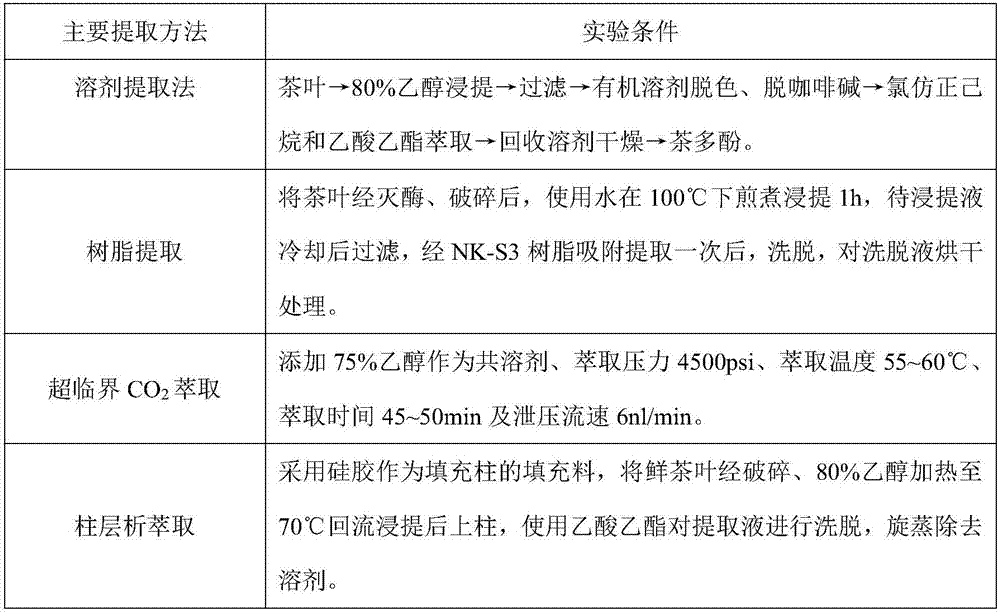Resin extraction process of high-purity tea polyphenol
An extraction process and technology for tea polyphenols are applied in the field of resin extraction process of high-purity tea polyphenols, and can solve the problems of incomplete extraction of tea polyphenols, low extraction efficiency, and difficulty in obtaining high-purity tea polyphenol products.
- Summary
- Abstract
- Description
- Claims
- Application Information
AI Technical Summary
Benefits of technology
Problems solved by technology
Method used
Image
Examples
Embodiment 1
[0041] A resin extraction process for high-purity tea polyphenols, comprising the following steps:
[0042] (1) Coarse separation of impurities:
[0043] A1: Heat the tea leaves to 280°C with microwave ovens and keep them for 3 minutes to inactivate the enzymes;
[0044] A2: Extract tea leaves with 70% ethanol solution, crush them with a dumb jaw crusher, cut and crush the tea leaves to a mesh size of 110-120 mesh, filter, repeat more than two times, and combine the filtrate;
[0045] A3: Maintain the temperature at 35-45°C, stir the filtrate and evaporate under negative pressure until the ethanol is basically volatilized;
[0046] A4: Hydration: add pure water to the solid-liquid mixture after step A3 until the solid is completely dissolved;
[0047] A5: Use chloroform to extract the filtrate, separate the liquid, remove the chloroform extraction layer, and keep the aqueous solution layer;
[0048] A6: Repeat step A5 more than twice, and combine the aqueous solution layer;...
Embodiment 2
[0064] A resin extraction process for high-purity tea polyphenols, comprising the following steps:
[0065] (1) Coarse separation of impurities:
[0066] A1: Heat the tea leaves to 260°C by microwave and keep for 4 minutes to inactivate the enzyme;
[0067] A2: Extract tea leaves with 70% ethanol solution, crush them with a hammer mill, cut and crush the tea leaves to a mesh size of 180-230 mesh, filter, repeat more than two times, and combine the filtrates;
[0068] A3: Maintain the temperature at 35-45°C, stir the filtrate and evaporate under negative pressure until the ethanol is basically volatilized;
[0069] A4: Hydration: add pure water to the solid-liquid mixture after step A3 until the solid is completely dissolved;
[0070] A5: Use chloroform to extract the filtrate, separate the liquid, remove the chloroform extraction layer, and keep the aqueous solution layer;
[0071] A6: Repeat step A5 more than twice, and combine the aqueous solution layer;
[0072] A7: Maint...
Embodiment 3
[0087] A resin extraction process for high-purity tea polyphenols, comprising the following steps:
[0088] (1) Coarse separation of impurities:
[0089] A1: Clean the tea leaves with a tea washing machine, then heat the tea leaves to 270°C with microwaves, and keep them for 3.5 minutes to inactivate the enzymes;
[0090] A2: Leach tea leaves with 70% ethanol solution, crush them with an ultrafine pulverizer, cut and crush the tea leaves to a mesh size of 240-280 mesh, filter, repeat more than two times, and combine the filtrates;
[0091] A3: Maintain the temperature at 35-45°C, stir the filtrate and evaporate under negative pressure until the ethanol is basically volatilized;
[0092] A4: Hydration: add pure water to the solid-liquid mixture after step A3 until the solid is completely dissolved;
[0093] A5: Use chloroform to extract the filtrate, separate the liquid, remove the chloroform extraction layer, and keep the aqueous solution layer;
[0094] A6: Repeat step A5 ...
PUM
| Property | Measurement | Unit |
|---|---|---|
| Aperture | aaaaa | aaaaa |
| Mesh | aaaaa | aaaaa |
| Mesh | aaaaa | aaaaa |
Abstract
Description
Claims
Application Information
 Login to View More
Login to View More - R&D
- Intellectual Property
- Life Sciences
- Materials
- Tech Scout
- Unparalleled Data Quality
- Higher Quality Content
- 60% Fewer Hallucinations
Browse by: Latest US Patents, China's latest patents, Technical Efficacy Thesaurus, Application Domain, Technology Topic, Popular Technical Reports.
© 2025 PatSnap. All rights reserved.Legal|Privacy policy|Modern Slavery Act Transparency Statement|Sitemap|About US| Contact US: help@patsnap.com


